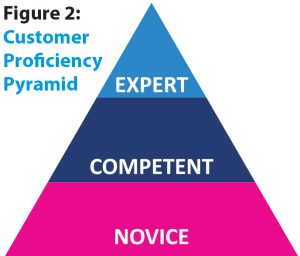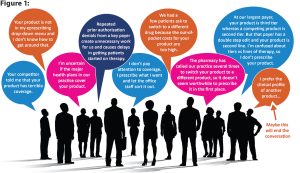
FIELD SALES – By Susan Baltrus and Sean Grant
Prepare your reps to make connections
Customers don’t always say what they mean. They often hide their market access concerns behind vague statements like, “We would prescribe your product more often if it were covered.”
This can stop a conversation in its tracks if your sales representative, account manager or field reimbursement manager (FRM) isn’t comfortable digging deeper to uncover and address the underlying access concern.
If customers were more forthcoming, perhaps they would articulate a more specific concern, such as those shown in Figure 1.
These examples of underlying issues also illustrate the wide range of customer understanding of market access – from novice to expert. To be effective, your field team must tailor their communication to the customer’s level of understanding so they can address specific concerns with precision.
One-size-fits-all responses like, “We have 93% coverage nationwide” or “I can refer you to our hub” fall short. Only in some cases are those the right answers. Maybe sales professionals who respond this way will be lucky and hit the right message, but usually they won’t, and the prescriber walks away thinking that they were right – your product really isn’t covered – and the opportunity is lost.
Another way sales professionals lose opportunities is by automatically triaging all market access questions to a colleague, such as an FRM, without pausing to fully understand the customer’s concern. On the other hand, sales professionals who can confidently deliver basic market access information demonstrate their value to customers while reserving FRM resources for more complex issues.
Building Three Key Skills
The three skills that field teams need to handle access concerns effectively are:
- Step 1: Assessing the customer’s level of access proficiency.
- Step 2: Asking powerful questions to uncover the underlying issue.
- Step 3: Delivering the right message with confidence, empathy and fluency.
Figure 2: Customer Proficiency Pyramid
Step 1: Assessing Proficiency
Training field teams to gauge a customer’s “access proficiency” or level of expertise involves a framework similar to this, with three or four levels of proficiency (Fig. 2). Field teams learn how to spot a customer’s level based on clues such as the words and phrases they use and the practice infrastructure.
This skill of assessing a customer’s market access proficiency and tailoring communications accordingly can be developed using a case study approach.
 Step 2: Asking Questions
Step 2: Asking Questions
Customers don’t like to play 20 questions! The field team needs to be efficient and ask the minimum number of questions to yield the maximum amount of information so they can determine the right action or message to deliver.
Equip your team with market access fundamentals (via fact sheets and modules) and questioning skills, and apply these in scenario-based workshops that provide plenty of practice so they can hone their skills.
Step 3: Delivering the Message
Armed with insights, the field team is ready to deliver a message that hits the mark. Does the customer need an explanation of the difference between tiers and lines of therapy? Is the customer interested in learning about financial assistance options? Or does the customer need to know Humana’s medical policy for the coverage of your product?
The field team needs to practice matching the right message to the situation, using the right resources and, if appropriate, triaging the issue to another individual or department.
Verbalization practice is a great way to build confidence and fluency, but role-plays can bore learners. A more engaging way to provide verbalization practice is a card game in which a rep on the “hot seat” draws a scenario card and demonstrates a response to earn points. Making the activity competitive amps up engagement, which helps learners internalize new approaches and messages.
Empathy for the Customer’s Situation
Understanding the customer’s world is crucial. An essential but often overlooked aspect of developing a customer-centric approach is training that enables learners to understand the environment in which the customer operates, including the customer’s pressures, priorities, tradeoffs and influences.
One way to build this deeper understanding of the customer’s point of view is for learners to step into their customer’s shoes for a couple of hours in an immersion exercise. Challenging learners to make decisions made by their customers helps them build empathy for the customer perspective.
When sales professionals step back into their own shoes, their understanding of the customer’s world and needs are more nuanced.
The Bottom Line
To conquer market access hurdles, field sales teams need a strong grasp of market access concepts, sharpened verbalization skills and proficiency in critical thinking, questioning and empathy.
Case studies, immersion exercises and competitive activities prepare learners to meet customers where they are and navigate market access conversations in ways they hadn’t considered.
 Susan Baltrus is president and CEO of Engage Rx Learning. Email her at sbaltrus@engagerxlearning.com or connect through linkedin.com/in/susan-baltrus-6910542.
Susan Baltrus is president and CEO of Engage Rx Learning. Email her at sbaltrus@engagerxlearning.com or connect through linkedin.com/in/susan-baltrus-6910542.
 Sean Grant is vice president of client relations, Engage Rx Learning. Email him at sgrant@engagerxlearning.com or connect through linkedin.com/in/seangrant77.
Sean Grant is vice president of client relations, Engage Rx Learning. Email him at sgrant@engagerxlearning.com or connect through linkedin.com/in/seangrant77.









